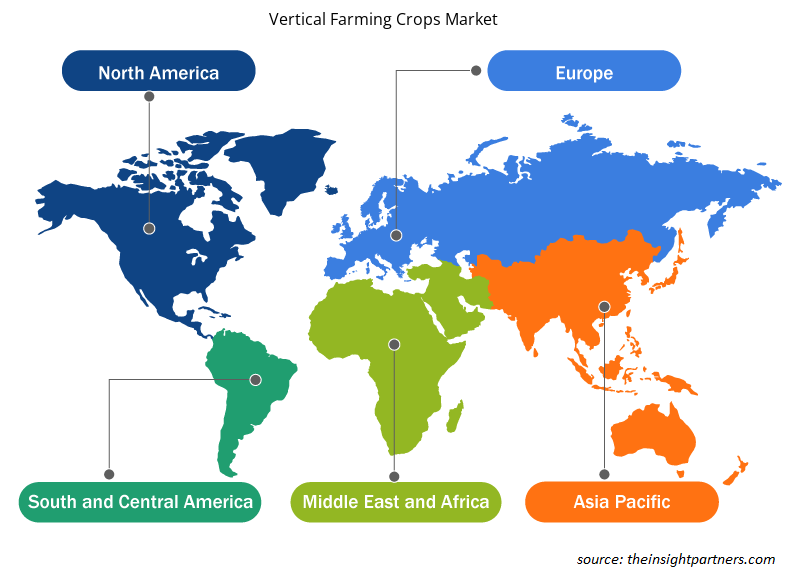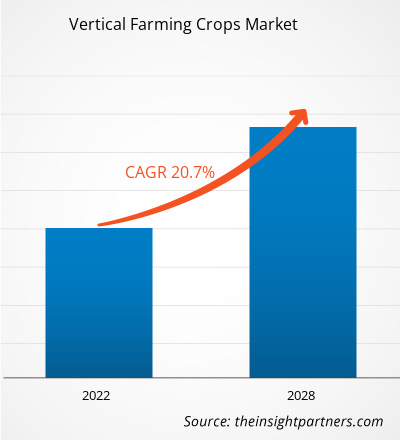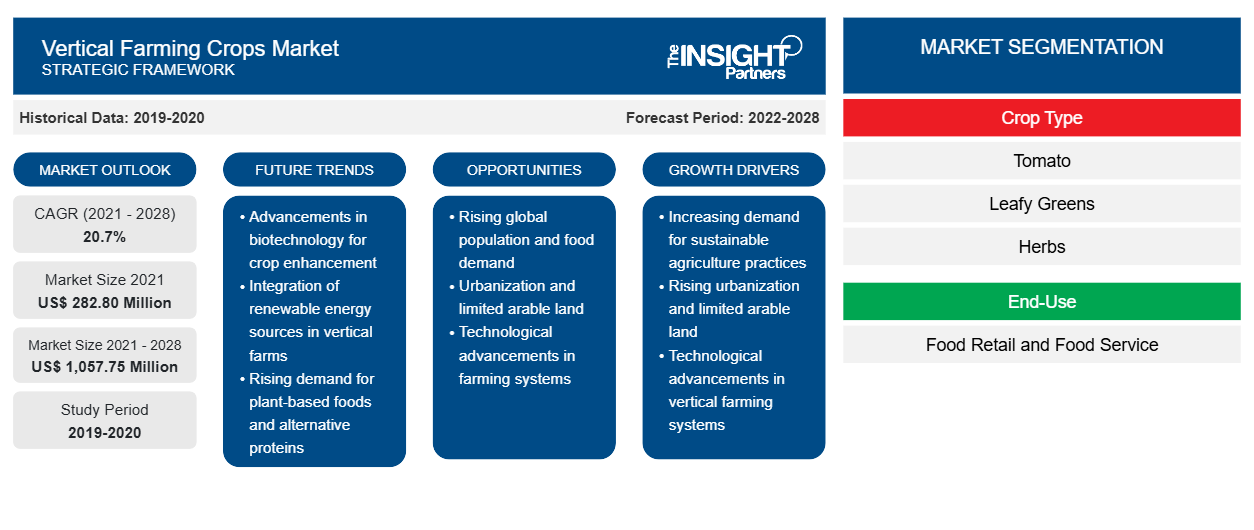[연구 보고서] 수직 농업 작물 시장은 2021년에 2억 8,280만 달러 규모로 평가되었으며, 2028년까지 1,057.75백만 달러에 도달할 것으로 예상됩니다. 2021년부터 2028년까지 20.7%의 CAGR로 성장할 것으로 예상됩니다.
수직 농업은 영양 매체로 구성된 트레이에 수직으로 쌓인 층으로 작물을 재배하는 것을 포함합니다. 작물을 재배하는 데 토양이나 땅을 사용하지 않는 현대 농업 기술입니다. 게다가, 기존 농업 관행에 일반적으로 사용되는 살충제, 화학 비료 또는 기타 합성 물질을 사용하지 않습니다. 수직 농업은 경작지가 부족한 도시 지역에서 점점 더 많이 채택되고 있습니다.
아시아 태평양 지역은 예측 기간 동안 글로벌 수직 농업 작물 시장 에서 가장 빠른 CAGR로 성장할 것으로 예상됩니다 . 시장을 촉진하는 주요 요인은 기술 혁신과 유기농 식품에 대한 수요 증가입니다. 아시아 태평양 지역의 인구는 극적으로 증가하고 있습니다. 증가하는 인구는 식량 수요를 자극하고 있으며, 이는 수직 농업 작물 시장 참여자에게 더 많은 기회를 제공합니다. 게다가 도시화의 증가와 현대 농업 관행의 채택 증가도 시장을 촉진하고 있습니다.
또한, 주요 수직 농업 작물 시장 참여자들은 혁신에 적극적으로 집중하고 있습니다. 주요 기업들은 R&D에 막대한 투자를 하고 있으며, 생산을 늘리기 위해 신기술을 도입하고 있습니다. 예를 들어, 시드니에 있는 신생 기업인 PodPlants는 가볍고 휴대하기 편리한 수직 정원을 개발했으며, 독특한 기술로 Australian Innovation Challenge에서 우승했습니다. 이러한 기술적 발전은 향후 지역 시장 성장을 촉진할 것으로 예상됩니다.
귀하의 요구 사항에 맞게 이 보고서를 사용자 정의하세요
이 보고서의 일부 또는 국가 수준 분석, Excel 데이터 팩을 포함하여 모든 보고서에 대한 사용자 정의를 무료로 받을 수 있으며 신생 기업 및 대학을 위한 훌륭한 혜택과 할인 혜택을 이용할 수 있습니다.
-
이 보고서의 주요 시장 동향을 알아보세요.이 무료 샘플에는 시장 동향부터 추정 및 예측까지 다양한 데이터 분석이 포함됩니다.
수직 농업 작물 시장에 대한 COVID-19의 영향
COVID-19 팬데믹은 글로벌 식음료 산업을 포함한 다양한 산업에 전례 없는 어려움을 가져왔습니다. 봉쇄, 여행 금지, 제조 공장 폐쇄로 인해 공급망이 심각하게 중단되어 매출이 감소했습니다. 게다가 제조 부문은 원자재와 노동력 부족으로 제품 공급이 부족했습니다. 그러나 수직 농업 작물 시장은 현지에서 생산된 신선하고 유기농 제품에 대한 수요로 인해 긍정적인 성장을 보였습니다. 게다가 개인의 건강 의식이 높아짐에 따라 향후 몇 년 동안 수직 농업 작물에 수익성 있는 성장 기회가 열릴 것으로 예상됩니다.
시장 통찰력
AI 제어 수직 농장의 인기 상승
AI 제어 수직 농장은 재배자가 작물의 성장 패턴, 더 나은 수확량을 제공하는 작물, 작물에 필요한 기후 조건 및 기타 요인과 관련된 데이터를 제공하여 작물 수확량을 최적화할 수 있도록 합니다. 재배자는 이 데이터를 분석하고 수확량을 개선하기 위해 필요한 조치를 취할 수 있습니다. 인공 지능(AI)은 주요 작물 성장을 제어하는 것부터 어떤 작물이 더 나은 수확량을 제공할지 예측하는 것까지 기후 변화 및 자원 부족과 같은 가장 큰 과제에 직면하는 데 도움이 될 수 있습니다. 인공 지능도 증가하고 있으며 1,600개가 넘는 신생 기업과 수천억 달러에 달하는 총 투자가 이루어지고 있습니다. AI 제어 로봇은 식물 성장을 모니터링하고 환경 요인을 지속적으로 조정하여 더 높은 효율성과 경제적 산출을 보장합니다. 따라서 인공 지능(AI)과 사물 인터넷(IoT)이 수직 농장 작물 시장의 주요 트렌드가 될 것으로 예상됩니다.
작물 유형 통찰력
작물 유형에 따라 수직 농업 작물 시장은 토마토, 잎이 많은 채소, 허브 및 기타로 세분화되었습니다. 잎이 많은 채소 세그먼트는 2019년에 가장 큰 시장 점유율을 차지했으며 허브 세그먼트는 예측 기간 동안 시장에서 가장 높은 CAGR을 기록할 것으로 예상됩니다. 잎이 많은 채소에는 상추, 케일, 콜라드 그린, 시금치, 미즈나, 비트 그린 및 마이크로그린이 포함됩니다. 잎이 많은 채소는 빠르게 재배할 수 있고 비교적 작은 공간에서 재배할 수 있기 때문에 실내 농업에 적합합니다. 식품 소매 및 식품 서비스 부문에서 신선한 잎이 많은 채소에 대한 수요가 증가하는 것은 세그먼트 성장을 촉진하는 주요 요인 중 하나입니다. 게다가 "농장에서 식탁까지 신선함"의 증가 추세도 수직 농업 잎이 많은 채소에 대한 수요를 촉진하고 있습니다. 잎이 많은 채소 작물의 실내 재배에 대한 연구 지출의 급증은 시장 성장을 위한 수익성 있는 기회를 제공하고 있습니다.
최종 사용 통찰력
최종 사용 산업을 기준으로 수직 농업 작물 시장은 식품 서비스와 식품 소매로 세분화되었습니다. 식품 소매 부문은 2020년에 더 큰 시장 점유율을 차지했습니다. 식품 서비스 부문은 지역 식품 유통업체, 레스토랑 및 카페, 패스트푸드 레스토랑에서 신선하고 고품질의 농산물에 대한 수요가 증가함에 따라 예측 기간 동안 더 높은 CAGR을 기록할 것으로 예상됩니다. 게다가 레스토랑과 카페에서 신선한 샐러드를 소비하려는 고객의 성향이 커지면서 식품 서비스 부문에서 수직 농업 작물에 대한 수요가 증가하고 있습니다. 일부 시장 참여자는 식품 서비스 제공업체와 협력하여 사업을 확장하고 있습니다. 예를 들어, 2019년 1월에 식품 서비스 공급업체인 Van Gelder와 PlantLab은 PlantLab의 완전 제어 수직 농업 부문에서 다양한 신선한 야채를 생산하기 위한 파트너십을 체결했습니다. 이러한 파트너십은 향후 몇 년 동안 시장을 더욱 활성화할 것으로 예상됩니다.
농업 기술 통찰력
농업 기술에 따라 수직 농업 작물 시장은 수경 재배, 에어로포닉스, 아쿠아포닉스로 세분화되었습니다. 수경 재배 부문은 2020년에 가장 큰 시장 점유율을 차지했으며 에어로포닉스 부문은 예측 기간 동안 시장에서 가장 높은 CAGR을 기록할 것으로 예상됩니다. 수경 재배에서 식물 뿌리는 영양 용액이 담긴 트레이에 담가집니다. 지난 몇 년 동안 수직 수경 재배 시스템을 사용한 도시 농업이 많은 주목을 받았습니다. 이러한 수경 농장은 최신 기술을 사용하여 식물 성장을 최적화하여 물 사용, 토지 공간, 운송 비용 및 살충제 사용을 최소화하면서 신선한 농산물을 제공할 수 있습니다. 수경 재배는 일반적으로 고품질 작물을 생산하며 인공 지능(AI) 및 사물 인터넷(IoT) 기술과 같은 새로운 기술을 채택함으로써 재배자는 더 나은 작물 수확량을 얻습니다.
글로벌 수직 농업 시장의 몇몇 주요 기업으로는 AeroFarms, Agricool, BOWERY FARMING INC., CropOne, Infarm, Plantlab, Plenty Unlimited Inc., Gotham Greens, MIRAI Co. Ltd., BrightFarms가 있습니다. 이 회사들은 작물 수확량을 높이고 저렴한 가격으로 고품질 작물을 생산하기 위해 신흥 기술에 막대한 금액을 투자하고 있습니다.
수직 농업 작물 시장 지역 통찰력
Insight Partners의 분석가들은 예측 기간 동안 수직 농업 작물 시장에 영향을 미치는 지역적 추세와 요인을 철저히 설명했습니다. 이 섹션에서는 또한 북미, 유럽, 아시아 태평양, 중동 및 아프리카, 남미 및 중미의 수직 농업 작물 시장 세그먼트와 지리에 대해서도 설명합니다.

- 수직 농업 작물 시장에 대한 지역별 데이터 얻기
수직 농업 작물 시장 보고서 범위
| 보고서 속성 | 세부 |
|---|---|
| 2021년 시장 규모 | 2억 8,280만 달러 |
| 2028년까지 시장 규모 | 1,057.75백만 달러 |
| 글로벌 CAGR (2021-2028) | 20.7% |
| 역사적 데이터 | 2019-2020 |
| 예측 기간 | 2022-2028 |
| 다루는 세그먼트 |
작물 유형별
|
| 포함된 지역 및 국가 |
북아메리카
|
| 시장 선도 기업 및 주요 회사 프로필 |
|
수직 농업 작물 시장 참여자 밀도: 비즈니스 역학에 미치는 영향 이해
수직 농업 작물 시장 시장은 소비자 선호도의 변화, 기술 발전, 제품의 이점에 대한 인식 증가와 같은 요인으로 인해 최종 사용자 수요가 증가함에 따라 빠르게 성장하고 있습니다. 수요가 증가함에 따라 기업은 제품을 확장하고, 소비자의 요구를 충족하기 위해 혁신하고, 새로운 트렌드를 활용하여 시장 성장을 더욱 촉진하고 있습니다.
시장 참여자 밀도는 특정 시장이나 산업 내에서 운영되는 회사나 기업의 분포를 말합니다. 주어진 시장 공간에 얼마나 많은 경쟁자(시장 참여자)가 존재하는지 그 규모나 총 시장 가치에 비해 나타냅니다.
수직 농업 작물 시장에서 운영되는 주요 회사는 다음과 같습니다.
- 에어로팜스
- 아그리쿨
- 보워리 파밍 주식회사
- 크롭원
- 인팜
면책 조항 : 위에 나열된 회사는 어떤 특별한 순서에 따라 순위가 매겨지지 않았습니다.

- 수직 농업 작물 시장의 주요 주요 업체 개요를 알아보세요
스포트라이트 보고서
- 수직 농업 작물 시장의 진보적인 산업 동향은 플레이어가 효과적인 장기 전략을 개발하는 데 도움이 됩니다.
- 선진국과 개발도상국 시장에서 채택한 사업 성장 전략
- 2019년부터 2028년까지 수직 농업 작물 시장의 정량적 분석
- 수직 농업 작물에 대한 세계 수요 추산
- 산업에서 운영되는 구매자와 공급자의 효율성을 보여주기 위한 PEST 분석
- 경쟁 시장 시나리오를 이해하기 위한 최근 개발
- 수직 농업 작물 시장 성장을 주도하고 제한하는 요인과 더불어 시장 동향 및 전망
- 상업적 관심을 뒷받침하는 시장 전략을 강조하여 의사 결정 프로세스를 지원하고 시장 성장을 이끕니다.
- 다양한 노드에서의 수직농업 작물시장 규모
- 시장의 자세한 개요 및 세분화, 그리고 수직 농업 작물 산업 역학
- 유망한 성장 기회가 있는 다양한 지역의 수직 농업 작물 시장 규모.
작물 유형에 따라 수직 농업 작물 시장은 토마토, 잎이 많은 채소, 허브 및 기타로 세분화됩니다. 최종 사용 산업에 따라 시장은 식품 소매 및 식품 서비스로 세분화됩니다. 농업 기술에 따라 시장은 수경 재배, 에어로포닉스 및 아쿠아포닉스로 세분화됩니다.
- 과거 분석(2년), 기준 연도, CAGR을 포함한 예측(7년)
- PEST 및 SWOT 분석
- 시장 규모 가치/거래량 - 글로벌, 지역, 국가
- 산업 및 경쟁 환경
- Excel 데이터세트
최근 보고서
사용 후기
구매 이유
- 정보에 기반한 의사 결정
- 시장 역학 이해
- 경쟁 분석
- 고객 인사이트
- 시장 예측
- 위험 완화
- 전략 기획
- 투자 타당성 분석
- 신흥 시장 파악
- 마케팅 전략 강화
- 운영 효율성 향상
- 규제 동향에 발맞춰 대응























 무료 샘플 받기 - 수직 농업 작물 시장
무료 샘플 받기 - 수직 농업 작물 시장